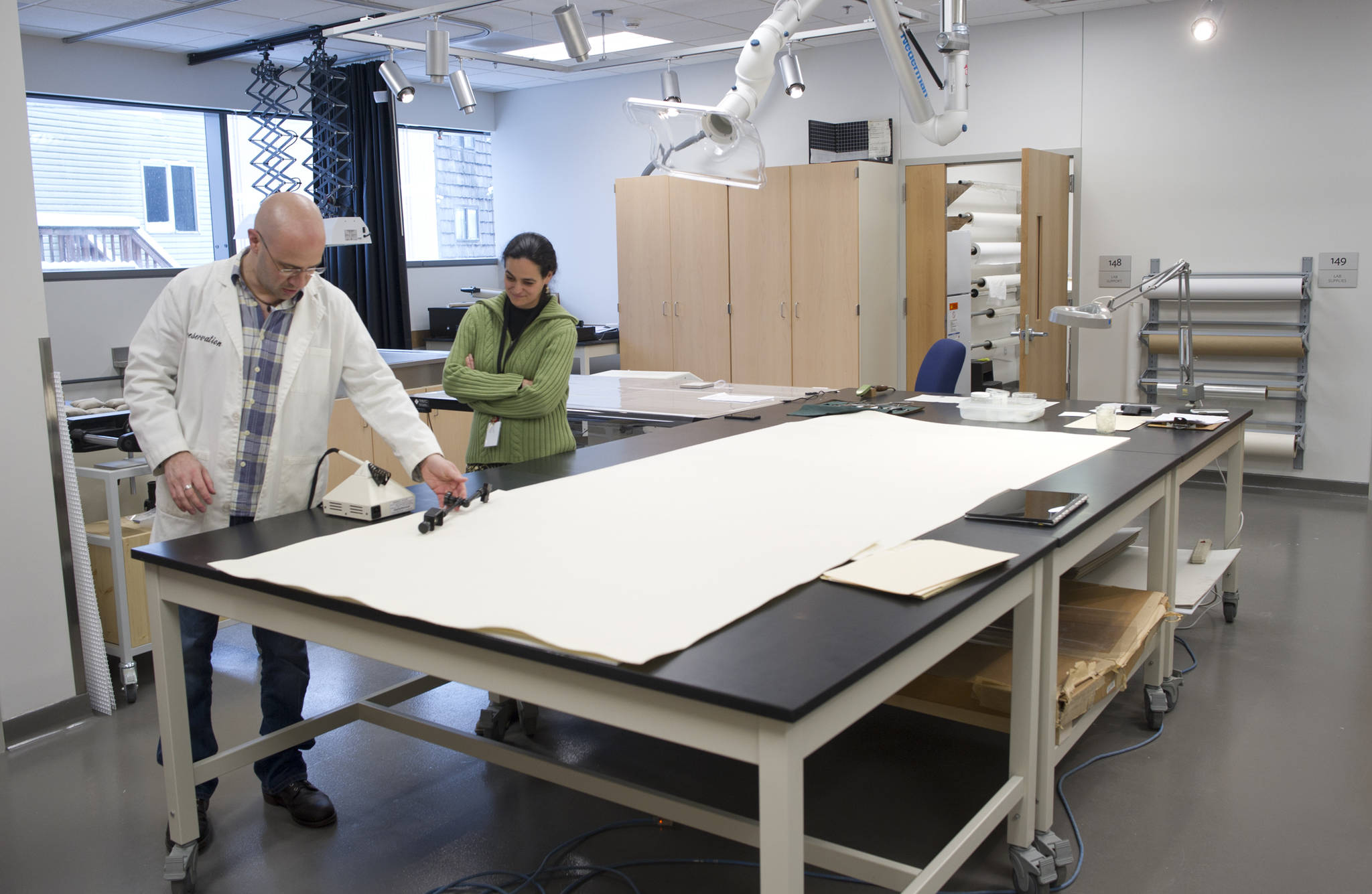Everyone has enemies.
Cats have dogs. Mice have cats. Dust mites have vacuum cleaners.
Seth Irwin has Scotch Tape.
For the past few weeks —and for a few more — Irwin is preserving and protecting some of Alaska’s most precious documents.
“Tape is my nemesis,” he said. “I spend a lot of time taking tape off of things. Painting conservators work with Monets; paper conservators deal with tape, and staples and rust … all the things office workers might put on documents.”
Irwin might not be dealing with precious paintings, but the paper conservator from Massachusetts has something critically important in his hands: Alaska’s irreplaceable history.
Take the object that was on his workbench at the State Library, Archives and Museum last week as an example. It was a 150-year-old map of Sitka, drawn not long after the Alaska Purchase was finalized in 1867.
Everyone knows the Purchase — its anniversary is a state holiday — but few people know what happened after Alaska was transferred. Americans and Russians needed to determine exactly what in Alaska was private property and what was public. In other words, this map dotted with colored and numbered lot lines determined exactly what the United States bought.
As Alaska celebrates the sesquicentennial of the Purchase, this map will be a key item in a museum exhibition later this year, explained objects conservator Ellen Carrlee.
It will appear alongside other documents and items from the critical year of 1867, but getting the map ready for display hasn’t been easy.
As he showed the map, Irwin placed a small glass beaker onto the workbench next to it. Filling the beaker was four to six feet of aged, fragmented cellophane tape.
“This was probably a full week of eight hours, 40 hours total,” he said, pointing to the beaker.
Anyone who’s ever removed a price sticker knows how hard it is to remove tape. Now, imagine trying to remove it from an irreplaceable 150-year-old piece of paper.
“I use nasty solvents, and it becomes kind of a bigger affair,” Irwin explained.
Without that affair, bad things happen. Irwin showed another document, this one dating from the 1880s, where a strip of tape had left a garish brown streak across the page. The paper beneath was torn, possibly because tape, left undisturbed for decades, can actually dissolve the paper beneath it.
Preventing that problem requires removing the tape, then, “once you take the tape off, guess what? There’s still a tear that needs to be addressed,” Irwin said.
Irwin uses Japanese tissue, a form of light, strong paper, to mend tears. For glue, he uses homebrewed wheat paste. To fix holes, he blends his own paper — there’s a kitchen blender on one lab counter — then uses an eyedropper to delicately fill the gap.
The work is one part chemistry, one part art history, and one part hand skills, Carlee said.
It’s the chemistry part that requires the most care.
Solvents — you might be familiar with paint thinner and nail polish remover, for example — give off toxic fumes, and they’re not always easy to handle safely.
When the state was designing its new library, archives and museum for Juneau, engineers realized that problem, then designed and built a capacious laboratory specifically to preserve and restore paper documents.
“We really saw there was this big need for paper conservation statewide,” Carrlee explained.
The resulting lab, where Irwin has been working, is the first of its kind in Alaska.
It has the scent of a high-school chemistry lab and the feel of a dentist’s office, not least because many of the tools Irwin uses — picks, probes, eyedroppers and delicate vacuums — have been repurposed from dental tools.
From the ceiling of the lab hangs a suction hose with a plastic hood at one end. From the floor sprouts a table dotted with pencil-thin suction holes, as if a vacuum cleaner’s mouth had been covered with a grate.
Using that suction table, a paper conservator can put caustic chemicals onto a piece of paper and have them sucked through the document before the single drop has a chance to blot across the page.
The hose, extended from the ceiling, whisks away any fumes.
The lab was completed last year in conjunction with the opening of the SLAM, but Irwin is the first person to use it: While the state had the money to build the lab, the crash in oil prices meant that Alaska couldn’t afford to staff it.
“Given the economics, we’re not likely to get another position,” Carrlee said.
Irwin’s visit was paid with a grant used to commemorate the 150th anniversary of the Purchase. In addition to restoring documents, he’s putting the lab through its paces and making sure all its new fittings work properly.
Irwin said the engineers seem to have done their job right, and he’s already been able to repair many of the documents the museum hired him to fix.
The map on Irwin’s table has survived for 150 years. Under his care, it will last for at least 150 more — and this time, no tape will be involved.
• Contact reporter James Brooks at james.k.brooks@juneauempire.com or call 419-7732.

